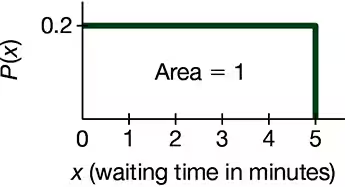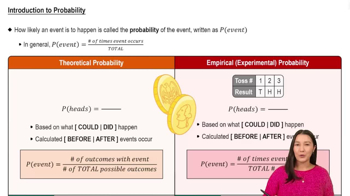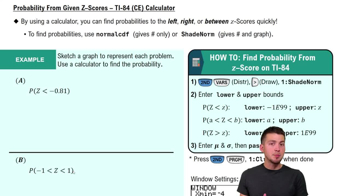Sketch a graph to represent the probability, then use a calculator to find it.
Table of contents
- 1. Intro to Stats and Collecting Data1h 14m
- 2. Describing Data with Tables and Graphs1h 55m
- 3. Describing Data Numerically2h 5m
- 4. Probability2h 16m
- 5. Binomial Distribution & Discrete Random Variables3h 6m
- 6. Normal Distribution and Continuous Random Variables2h 11m
- 7. Sampling Distributions & Confidence Intervals: Mean3h 23m
- Sampling Distribution of the Sample Mean and Central Limit Theorem19m
- Distribution of Sample Mean - Excel23m
- Introduction to Confidence Intervals15m
- Confidence Intervals for Population Mean1h 18m
- Determining the Minimum Sample Size Required12m
- Finding Probabilities and T Critical Values - Excel28m
- Confidence Intervals for Population Means - Excel25m
- 8. Sampling Distributions & Confidence Intervals: Proportion1h 12m
- 9. Hypothesis Testing for One Sample3h 29m
- 10. Hypothesis Testing for Two Samples4h 50m
- Two Proportions1h 13m
- Two Proportions Hypothesis Test - Excel28m
- Two Means - Unknown, Unequal Variance1h 3m
- Two Means - Unknown Variances Hypothesis Test - Excel12m
- Two Means - Unknown, Equal Variance15m
- Two Means - Unknown, Equal Variances Hypothesis Test - Excel9m
- Two Means - Known Variance12m
- Two Means - Sigma Known Hypothesis Test - Excel21m
- Two Means - Matched Pairs (Dependent Samples)42m
- Matched Pairs Hypothesis Test - Excel12m
- 11. Correlation1h 6m
- 12. Regression1h 50m
- 13. Chi-Square Tests & Goodness of Fit1h 57m
- 14. ANOVA1h 57m
6. Normal Distribution and Continuous Random Variables
Probabilities & Z-Scores w/ Graphing Calculator
Problem 6.1.6
Textbook Question
Continuous Uniform Distribution. In Exercises 5–8, refer to the continuous uniform distribution depicted in Figure 6-2 and described in Example 1. Assume that a passenger is randomly selected, and find the probability that the waiting time is within the given range.

Less than 4.00 minutes
 Verified step by step guidance
Verified step by step guidance1
Step 1: Understand the continuous uniform distribution. In this case, the waiting time is uniformly distributed between 0 and 5 minutes, as shown in the graph. The probability density function (PDF) is constant at 0.2, and the total area under the curve equals 1.
Step 2: Recall the formula for the probability in a continuous uniform distribution. The probability of a random variable falling within a range [a, b] is given by the area under the curve between those limits. This is calculated as P(a ≤ X ≤ b) = (b - a) × f(x), where f(x) is the constant height of the PDF.
Step 3: Identify the range of interest. The problem asks for the probability that the waiting time is less than 4.00 minutes. This corresponds to the range [0, 4].
Step 4: Apply the formula. Substitute the values into the formula: P(0 ≤ X ≤ 4) = (4 - 0) × 0.2. This represents the area of the rectangle from x = 0 to x = 4 under the curve.
Step 5: Interpret the result. The calculated area represents the probability that the waiting time is less than 4.00 minutes. This probability is proportional to the area under the curve within the specified range.
 Verified video answer for a similar problem:
Verified video answer for a similar problem:This video solution was recommended by our tutors as helpful for the problem above
Video duration:
2mPlay a video:
Was this helpful?
Key Concepts
Here are the essential concepts you must grasp in order to answer the question correctly.
Continuous Uniform Distribution
A continuous uniform distribution is a probability distribution where all outcomes are equally likely within a specified range. The probability density function (PDF) is constant across this range, resulting in a rectangular shape when graphed. For example, if waiting times are uniformly distributed between 0 and 5 minutes, every time within this interval has the same likelihood of occurring.
Recommended video:

Uniform Distribution
Probability Density Function (PDF)
The probability density function (PDF) describes the likelihood of a continuous random variable taking on a specific value. In the case of a continuous uniform distribution, the PDF is a horizontal line, indicating that the probability is evenly distributed across the range. The area under the PDF curve represents the total probability, which equals 1 for a valid distribution.
Recommended video:

Introduction to Probability
Calculating Probability
To find the probability of a continuous random variable falling within a certain range, you calculate the area under the PDF over that interval. For example, to find the probability that a passenger's waiting time is less than 4 minutes in a uniform distribution from 0 to 5 minutes, you would determine the area of the rectangle formed by the interval from 0 to 4, which is the height of the PDF multiplied by the width of the interval.
Recommended video:
Guided course

Probability From Given Z-Scores - TI-84 (CE) Calculator

 7:09m
7:09mWatch next
Master Probability From Given Z-Scores - TI-84 (CE) Calculator with a bite sized video explanation from Patrick
Start learningRelated Videos
Related Practice
Multiple Choice
